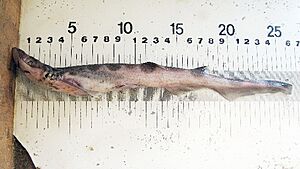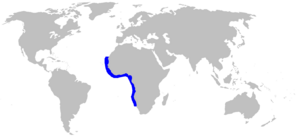African sawtail catshark facts for kids
Quick facts for kids African sawtail catshark |
|
|---|---|
 |
|
| Conservation status | |
| Scientific classification | |
| Genus: |
Galeus
|
| Species: |
polli
|
 |
|
| Range of the African sawtail catshark | |
The African sawtail catshark (Galeus polli) is a type of catshark. It belongs to the Scyliorhinidae family. This shark lives near the bottom of the ocean. You can find it off the western African coast. It lives in waters from Morocco all the way to South Africa.
This shark is quite slender and has a long, pointed snout. It has dark saddle-like markings along its back and tail. A special feature is a crest of saw-like scales along the top edge of its tail fin. The biggest African sawtail catshark ever found was about 46 cm (18 in) long.
African sawtail catsharks eat small bony fishes, squid, and crustaceans. They are unique because they give birth to live young. Most other sharks in their group lay eggs. Females can have up to 12 pups at a time, all year round.
Sometimes, these sharks are accidentally caught by fishing boats. This happens in shallower waters. They might be used for food or to make fishmeal. However, the fishing in places like Namibia, where many of these sharks live, is well-managed. This means their numbers are not usually threatened. Because of this, the International Union for Conservation of Nature (IUCN) says this species is Vulnerable.
Contents
What is the African Sawtail Catshark?
The African sawtail catshark is a fascinating deep-sea creature. It's known for its unique appearance and how it reproduces. This shark is a great example of the diverse life found in our oceans.
How Was This Shark Discovered?
In 1953, a scientist named Max Poll wrote a report about sharks. He found some catsharks off western Africa that seemed to give birth to live young. This was strange because the similar blackmouth catshark lays eggs.
Another scientist, Jean Cadenat, then studied more of these sharks. He realized they were a completely new species! In 1959, he officially described the new shark. He named it in honor of Max Poll.
Where Does the African Sawtail Catshark Live?
The African sawtail catshark lives along the western coast of Africa. Its home stretches from southern Morocco down to the Northern Cape Province in South Africa. It is very common off the coast of Namibia. However, it is rare south of the Orange River.
What Kind of Habitat Does It Prefer?
This shark lives on the outer part of the continental shelf. It also lives on the upper continental slope. This means it lives in deep waters, between 160 and 720 m (520 and 2,360 ft) deep. It is most often found at depths of 258–490 m (846–1,608 ft). This shark lives on or near the ocean bottom. It can even live in water with low levels of oxygen.
What Does the African Sawtail Catshark Look Like?
The African sawtail catshark can grow up to 46 cm (18 in) long. Female sharks are usually a bit bigger than males. It has a slender body and a slightly flat head. Its snout is long and pointed.
Special Features of Its Body
- Nose: Each nostril has a small, triangular flap of skin.
- Eyes: Its eyes are oval-shaped. They have small protective eyelids, like a third eyelid.
- Mouth: The mouth is wide and curved. It has small grooves at the corners.
- Teeth: Its teeth have a main point and one or two smaller points on the sides.
- Gills: It has five pairs of gill slits.
Fins and Skin
The shark has two dorsal fins, which are blunt and similar in size. Its pectoral fins are large and wide. The pelvic fins and anal fin are longer and more angled.
A unique feature is the crest of saw-like scales along the top edge of its tail fin. These scales are called dermal denticles. The shark is dark on top and light on the bottom. It usually has dark gray or brown saddle-like markings. These markings are outlined in white. Older sharks might lose these patterns and become a single color. The inside of its mouth is black.
What Does the African Sawtail Catshark Eat and How Does It Live?
The main food for the African sawtail catshark is small bony fishes. These include lanternfishes, hakes, and grenadiers. It also eats squid and crustaceans.
Who Are Its Predators?
One known predator of this shark is the southern African frilled shark.
How Does It Reproduce?
Unlike most other sharks in its group, the African sawtail catshark gives birth to live young. The females keep the eggs inside their bodies until they hatch. There isn't a specific breeding season. Mating and birth happen all year long.
Female sharks have two working uteruses. They can have up to 12 pups in one litter. Larger females tend to have more pups. The baby sharks are born measuring 10–18 cm (3.9–7.1 in) long. Males become mature when they are 30–46 cm (12–18 in) long. Females become mature at 30–43 cm (12–17 in) long.
How Do Humans Interact with This Shark?
In some shallower areas where this shark lives, there is a lot of fishing. The African sawtail catshark is often caught by accident in large fishing nets called bottom trawls. When caught, these sharks might be sold for food or turned into fishmeal.
However, this shark is mostly safe from fishing in deeper waters. Also, the fishing industry in Namibia, where many of these sharks live, is well-controlled. Because of these reasons, the International Union for Conservation of Nature (IUCN) has listed the African sawtail catshark as Vulnerable. This means it needs some protection, but it's not in immediate danger of disappearing.
Images for kids




